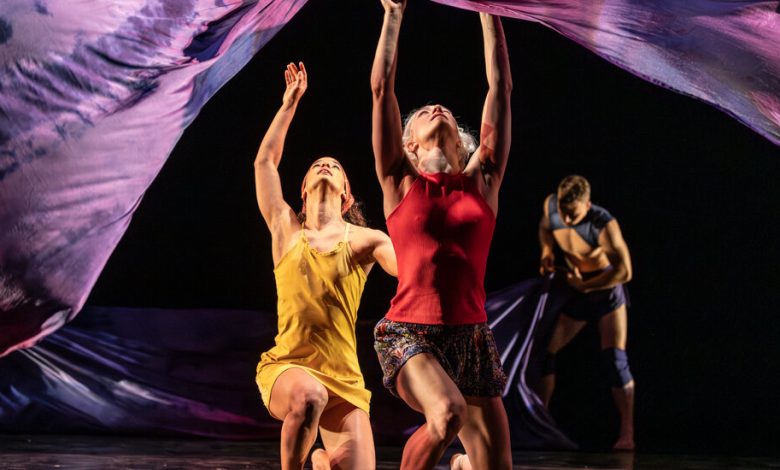Review: Delayed by the Pandemic, Pilobolus Celebrates Its 50th

Pilobolus has been pushing bodies to their limits in unusual shapes and precarious balances since 1971, when its founding members met at Dartmouth College. The company’s leadership has shifted and changed over the years, but what remains is the group’s collaborative approach. If a uniform mentality prevails — all for one and one for all — it’s partly because of the nature of its acrobatic, robust choreography. Strength is a must and so is trust.
The group also possesses commercial appeal despite the origins of its name: Pilobolus is a genus of fungi that grows on herbivore dung. Now under the leadership of Renée Jaworski and Matt Kent — two former company members — Pilobolus, after a pandemic delay, concludes its 50th anniversary tour with a three-week season at the Joyce Theater. Its title, the “Big Five-OH!,” has much in common with aspects of the group’s choreography, which can veer into the painfully cute.
“Evening Song,” one of two New York premieres on Tuesday’s opening-night program, is a dreamlike journey in which six dancers share the stage with a crucial piece of scenery: A long piece of tie-dye fabric that changes over time. When a dancer held it under her shirt, she suddenly appeared pregnant; next, the fabric was stretched out like an umbilical cord before assuming the shape of a cradled infant.
Created by Derion Loman, Madison Olandt, Jaworski and Kent in collaboration with six dancers, “Evening Song” is set to an ever-shifting and sometimes bumpy sound score by Jad Abumrad — spare piano gives way to a whistling teakettle and later to the song “Stay Awake” from “Mary Poppins.” The work focuses on the company’s powerful women, Marlon Feliz and Hannah Klinkman.
Dressed in vibrant colors by Valerie St. Pierre Smith — yellow for Feliz and red for Klinkman — the women contrasted with the men who were costumed scantily (and tackily) in fabric resembling armor. Feliz and Klinkman, held in the air, became angelic figures as they seemed to float in slow motion, lending a religious, painterly aspect to the imagery. But “Evening Song” was more pictorial than penetrating as it began to drag out — like most of the works on the program — the dancers stamping the stage with repeated movement motifs that relied on their flexibility and highly tuned physicality to create sculptural tableaus.
The other New York premiere, “The Ballad,” created by Darlene Kascak, Jaworski and Kent in collaboration with seven dancers, features narration by Kascak, a traditional Native American storyteller, alongside a soundscape by Ben Sollee. Taking center stage is a young girl in a blue dress (Feliz); Kascak’s voice-over discusses the mistreatment and abuse of Indigenous children and her experience of being taken from her mother, an activist, and placed in foster care.
Mixed in is text about the legend of the Wendigo, a human turned cannibal. Once the monsters bite, their victims turn into cannibals, too. If the Wendigo was a human whose selfishness “overpowered their self control,” Kascak says, the modern-day equivalents are corporations.
All the while, the choreography acts out the story, making the whole endeavor, however well-intentioned, more of a school play than an affecting piece of dance theater. Feliz falls into the world of the Wendigo — masked, crouching dancers who grab her feet as she tries to walk — and is passed over their hulking forms. Ultimately, the layered stories take on a hopeful note as Kascak speaks about how it is time for humans to take backward steps “in order to restore balance” to the earth.
In “Branches,” Jaworski and Kent — in collaboration with others — also point a lens at the natural world, but here the imagery is often too obvious and, again, cute. The dancers dip their toes and hands into a pool of invisible water, or twitch to the sounds of bird calls. It’s full of starts and stops until, to the sound of flapping wings, they rush decisively offstage.
The program led off with more familiar glimpses into the Pilobolus universe: The vaudevillian solo from Michael Tracy’s “Empty Suitor” as performed by Nathaniel Buchsbaum, and “Megawatt,” an energetic work for six, restaged in the memory of Jonathan Wolken, its choreographer who died in 2010, in collaboration with seven others.
To music by Primus, Radiohead and Squarepusher, “Megawatt” opened with dancers inching across the stage on their backs, eventually curling and rising onto two feet to burst into the air like popcorn. Are they skilled? No question. But facial expressions were next level, too — and not in an entirely effective way. Sometimes, even in a dance called “Megawatt,” the power needs to come from toning it down.
Pilobolus
Through July 30 at the Joyce Theater, Manhattan; joyce.org.



